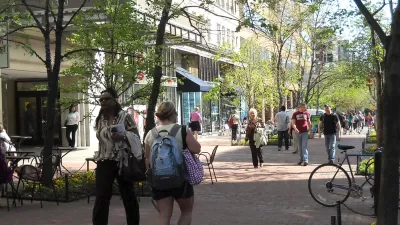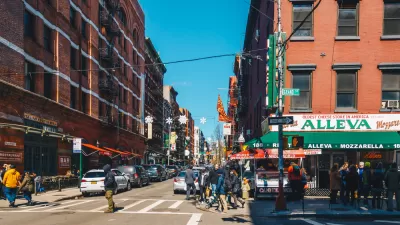Millennials and an aging Baby Boomer population have put a premium on "the hottest trend in real estate": walkability.

Via the Huffington Post, F. Kaid Benfield of PlaceMakers writes that the most sought after amenity for renters and buyers is now 'walkability'. Access to services, shops, restaurants and transportation is now a huge consideration for millennials and baby boomers, whether they prefer to live in the suburbs or in the urban core. Benfield cites a nationwide survey by the National Association of Realtors and Portland State University that found 'walkability' as an important factor in the selection of where people live.
Across all generations, the Realtors/Portland State survey found that an overwhelming majority of respondents - 79 percent - believe it to be very or somewhat important, in choosing a home, to be "within an easy walk of other places and things in the community." It also found that people who now live in such neighborhoods are especially satisfied with the quality of life in their communities. Fifty-four percent of those respondents who agreed with the statement "there are lots of places to walk nearby, such as shops, cafes, and restaurants" reported being very satisfied with the quality of life in their communities; only 41 percent of all respondents reported being very satisfied.
Benfield notes that while most cities across the United States have areas that can be considered 'walkable', there aren’t enough to meet demand.
And, because their supply is limited, prices for walkable locations are sky-high. Research has shown that each one-point increase in a home's Walk Score (a 100-point scale measuring an address's accessibility to walkable destinations) is associated with a $700 to $3000 increase in its value compared to less walkable homes of comparable size.
So what can be done to create more walkable areas in our cities and suburbs? Banfield offers a few good solutions, including the implementation of form-based codes and a focus on LEED for Neighborhood Development when updating that existing zoning codes.
FULL STORY: We Want More Walkable Neighborhoods -- but Can Our Communities Deliver?

Pennsylvania Mall Conversion Bill Passes House
If passed, the bill would promote the adaptive reuse of defunct commercial buildings.

Planning for Accessibility: Proximity is More Important than Mobility
Accessibility-based planning minimizes the distance that people must travel to reach desired services and activities. Measured this way, increased density can provide more total benefits than increased speeds.

World's Largest Wildlife Overpass In the Works in Los Angeles County
Caltrans will soon close half of the 101 Freeway in order to continue construction of the Wallis Annenberg Wildlife Crossing near Agoura Hills in Los Angeles County.

Maine Approves Rent Relief Program
Legislators hope the assistance program will help struggling low-income households avoid eviction.

How Transit Architecture Impacts Real and Perceived Safety
More than a third of Americans believe major transit systems are too unsafe to ride. The built environment can change that.

New York Passes Housing Package Focused on New Development and Adaptive Reuse
The FY 2025 budget includes a new tax incentive, funding for affordable housing on state land, and support for adaptive reuse and ADUs.
City of Costa Mesa
Licking County
Barrett Planning Group LLC
HUD's Office of Policy Development and Research
Mpact Transit + Community
HUD's Office of Policy Development and Research
Tufts University, Department of Urban and Environmental Policy & Planning
City of Universal City TX
ULI Northwest Arkansas
Urban Design for Planners 1: Software Tools
This six-course series explores essential urban design concepts using open source software and equips planners with the tools they need to participate fully in the urban design process.
Planning for Universal Design
Learn the tools for implementing Universal Design in planning regulations.
























